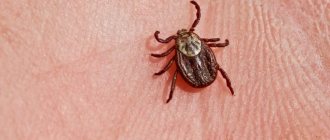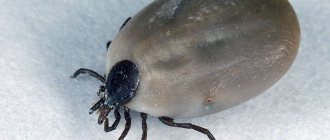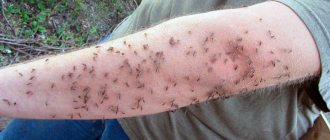Prevention: how to deal with ticks?
Obviously, it is impossible to eliminate all ticks in the forest, but treating a summer cottage is a feasible task. To begin with, it is worth making it uncomfortable for parasites to live in.
- Ticks love uncut grass, but they do not like trimmed lawns and paths with crushed stone or paving stones.
- Insects live in the shade and hide from the bright rays of the sun.
- The parasites move little and mostly wait for a passing victim.
- The tick senses its provider by thermal radiation and settles in advance where a person most often happens: on the grass or bushes near a bench, gazebo, washstand, or near the porch of a house.
If your dacha borders an abandoned area, or is located near a forest or field, animals or birds may bring insects from there. To block the path of ticks, it is recommended to mow the grass in the area, or at least along its perimeter. The tick senses prey 20 meters away; infected ticks have higher search activity. And, although he moves 10 meters per day, if nothing stops him on the way, he will independently reach the so-called feeder.
Last year's leaves, grass and plant tops should be collected in a compost pit, burned or buried. Ticks lay eggs in it. Paths and areas around benches and rest areas should be covered with gravel or sand. A concrete pavement around the house and outbuildings will prevent insects from entering the house and hiding there.
Reasons for the appearance of ticks in a summer cottage
The following can be distinguished:
- Food shortage, stimulating the search for new places. In a day they can cover distances of 10 m to find food.
- Placing a summer cottage near a forest.
- The appearance of parasites among neighbors.
- Bringing them in with the help of pets.
- When purchasing a plot, there is a risk of ticks. If they appear after 18-24 months, they were present initially, since their eggs mature during this time.
How to repel ticks?
Folk repellents that are safe for humans and animals are, first of all, plants with a characteristic intense aroma. Ticks don't like the smell:
- tansy;
- mint;
- marigolds;
- sage;
- thyme;
- rosemary;
- lavender;
- geraniums;
- garlic;
- pharmaceutical chamomile.
A hedge around the perimeter of the site will repel harmful insects. If you did not have time to plant these flowers and plants, you can spray a solution of essential oils with water throughout the area. In addition to the oils recommended for planting, eucalyptus oil is used. Obviously, spraying the area will take a lot of time and treatment will have to be carried out constantly.
The most effective folk remedies against ticks
You can also use folk recipes. They are safer for humans, animals and vegetation. The main thing is to make sure that the composition does not contain components that can cause allergies.
Pests cannot tolerate the strong odors of essential oils, citrus fruits and some herbs, so you need to take advantage of this:
- Citrus juice. Lemons, tangerines, grapefruits and oranges are suitable for its preparation. Cut the fruit in the middle and squeeze out all the liquid from it. Add three liters of water to it and spray the area with the mixture.
- Herbal infusion. Take chamomile, sage, geranium and garlic flowers. Place them in a large saucepan of boiling water and simmer for 5 minutes. Pour the solution into a jar and let it brew for two days. Strain the resulting liquid and treat the area with it using a spray bottle.
- Essential oils. Dilute 5 ml of rosemary and peppermint essential oils per liter of water. Spray the area with the resulting mixture every two months.
- Garlic tincture. Peel a large head of garlic and grate it. Fill the pulp with two liters of water. Place in a dark place (pantry, cellar or basement) for a day. After the specified time, strain and pour in two more liters of water. Spray the garden several times until the mites are completely gone. Garlic can be replaced with an onion - the result will be similar.
Advice from a reader I fight ticks in my dacha using a mechanical method. My husband and I stretch a white cloth (a sheet works great) and slowly walk across the grass for about 5-10 minutes. After this, we burn the detected pests. Alina
Some gardeners use various plants as a repeller. You just need to plant them on your site:
- Common tansy. Repels various pests due to its pungent odor, reminiscent of camphor. In addition, it helps in the fight against fungi. Loves clay soil rich in nutrients. Grows best in sunny locations.
- Catnip (Catnip). A small plant (up to 40 cm) with a pungent aroma. It is its smell and essential oils in the inflorescences that parasites do not like. Does not require maintenance.
- Lavender angustifolia. Repels ticks with the strong scent of flowers. They also contain essential oils that arachnids and mosquitoes do not like. For planting, choose alkaline soil and sunny places. Tolerates drought but requires annual pruning in spring.
- Rosemary is officinalis. Ticks cannot stand its smell. The plant has medicinal properties. Prefers sunny places and well-drained soil. It is better to grow in flowerpots, since rosemary does not tolerate temperature changes and will not be able to overwinter in open ground.
- Dalmatian chamomile. Contains components toxic to arthropods. Thus, it affects the muscles and nervous system of pests. Grows best in fertile soil and sunny locations.
How to protect your site?
If you removed a tick from a pet, or noticed it in the grass, then you need to move from prevention to active control of insects. Methods of controlling ticks are divided into mechanical and chemical. The first one can be practiced independently, the second one is better left to professionals.
Mechanical method
The mechanical method involves collecting ticks from grass and bushes. A piece of white fleecy fabric the size of a pillowcase is secured to a long stick. The cloth is passed over the surface of the area in the morning or evening, when there is no bright sun. To make insects more willing to cling to the fabric, it is recommended to soak it with sweat.
The fabric along with the insects is burned. Killing ticks with your hands is dangerous: if they are infected, you can become infected. Place the cloth with insects in a metal basin or on a sheet of metal, pour kerosene on it and burn it without hesitation.
Chemicals
Any chemical preparation for treating summer cottages, gardens and vegetable gardens against ticks is, by definition, not safe. Violation of safety measures and instructions may threaten the life and health of people and animals.
Treatment with chemicals is carried out at least 40 days before the expected harvest and the fruits and vegetables that enter the treatment area are thoroughly washed.
It is necessary to correctly calculate the dosage so that it is effective in eliminating ticks and acceptable for the person who will spray the chemical. The area is thoroughly sprayed, especially the lower branches of plants and bushes. The grass is mowed and removed before processing.
Ticks are killed with insecticides, acaricides and insectoacaricides:
- DDT is a dust that is extremely toxic and accumulates in the soil.
- Organophosphorus compounds are toxic; if they come into contact with the skin, they cause poisoning. Upon contact with soil and air, they are quickly neutralized, breaking down into low-hazard elements.
- Pyrethroids are the safest substances; after treating the area, they quickly decompose.
Review of chemicals
Today, the following products are considered the most common and available for purchase:
| Sipaz-super | Kills ixodid ticks, mosquitoes, bedbugs, fleas, flies and cockroaches. Active ingredient: cypermethrin. The drug has no pronounced odor, the residual effect lasts up to one and a half months. |
| Cifox | Effective against ixodid and scabies mites. Kills ants, fleas, and flies. The effect lasts up to 3 months. It is made on the basis of cypermethrin and has a specific odor. |
| Titanium | Used by gardeners to prevent fungus and other plant damage. Made from propiconazole (pesticide, fungicide). |
| Force site | Kills ticks of all types, has a rich odor, and disappears quickly. Made on the basis of fenthion, low-hazard to humans. |
| Acaritox | A substance based on alphacypermethrin kills ixodid ticks. Protection lasts up to 1.5 months. Low danger to humans. |
Features of the use of chemicals
Tick control products are sprayed with a garden sprayer or hand sprayer.
When treating an area using liquid chemicals, the following protective equipment is required:
- headdress;
- safety glasses with wide lenses that fit tightly to the face;
- respirator for respiratory protection;
- overalls: robe and trousers covering the entire surface of the body. After processing, workwear must be removed and ventilated, and then washed.
- Rubber gloves or leggings.
Treatment should be carried out in dry, windless weather, on a moderately sunny day. Pets, children, people with allergies and food should not be in the treatment area.
Chemicals should not be allowed into wells, drinking water sources or bodies of water.
Bees and fish die from some drugs; this must be taken into account when choosing a means of treating an area.
When treating an area against ticks, correctly calculate the dosage and the appropriate preparation. Otherwise, you risk poisoning and putting family members in danger. Even chemists invite specialists to treat garden plots against ticks. They do this precisely because they correctly assess the risks of inept use of chemicals.
Identification of parasites, mechanical extermination method
Destruction of mites mechanically involves collecting parasites from plants. To do this, you will need a stick about one and a half meters long, with a white cloth wrapped around it (this will make it easier to see any pests).
The fabric should be coarse or fleecy (cloth, linen, waffle towel are suitable) to make it easier for ticks to cling to it. And since parasites are guided by the smell and warmth of the body, you first need to wipe your face, neck, and hands with this cloth.
By slowly walking the wrapped part of a stick along the rows of plants, you can collect a very large number of mites at one time, and if this procedure is carried out regularly, the pest population in the area will noticeably decrease.
The photo shows an example of collecting insects on a stick with a white cloth
It is best to collect ticks in the morning and evening hours, when the sun is not so high in the sky. At this time they are most active. It is more advisable to burn the parasites that come across; crushing them with your hands and feet is inconvenient (they have a hard body) and dangerous (there is a risk of infection if the tick was a carrier of the virus).
The described method is also used to detect the presence of ticks in the area. If, during such a procedure, not a single parasite was found on the fabric, it means that the garden is not infected with them and chemical methods of control can be abandoned.
Personal protection against ticks for people and pets
If an area is cleared of ticks, this, alas, does not mean that you are protected from them elsewhere. Therefore, when going for a walk in the forest, on the field or to the lake, apply repellent sprays to your clothes: “Off!”, “Medelis”, “Reftamid-MaximumExtreme”. Process the edges of the clothing - cuffs, trouser legs, collar. Do not spray the mixture in your face or inhale it.
As soon as you return from a walk, undress, shake out your clothes outside and carefully examine your skin to make sure that you are not wearing ticks.
Pets are often victims of ticks. It is recommended to combine a flea and tick collar with the application of anti-tick medications: Frontline, Bolfo, Proposkur. Before purchasing, read the instructions: not all drugs can be used for pregnant animals and young animals.
What to do if a tick gets stuck?
When a tick lands on the body of its host, it begins to look for the most convenient place: the scalp, skin behind the ears, armpits, groin area. There is delicate and thin skin with many superficial blood vessels.
Usually a person does not feel how the tick bites: the insect’s saliva contains an analgesic, this allows it to quietly attach itself to the vessel and drink blood. After some time, swelling and thickening at the site of the bite becomes noticeable. It is impossible not to notice the body of a tick, but, unfortunately, this can happen when the insect has already bitten into it.
You should not remove the parasite yourself. The doctor will do this quickly, painlessly and immediately send him for examination. If necessary, the victim will immediately be given an injection of anti-tick immunoglobulin.
If it is impossible to get to a doctor, you need to eliminate the tick as soon as possible. If it is infected, remaining at the site of the bite will increase the risk of infection.
Hold the insect's body as close to the proboscis as possible with tweezers and slowly pull it out. A sudden movement can rupture the body, then part of it will remain under the skin, and the wound will begin to fester.
If the tick has been removed, it must be placed in a jar of water and taken to the laboratory. Symptoms of infection may appear 3-7 days after the bite.
FAQ
What can you get infected from an ixodid tick bite?
Viral infections:
- Tick-borne encephalitis
- Omsk hemorrhagic fever
- Kyasanur Forest Disease
- Crimean-Congo hemorrhagic fever
Bacterial infections:
- Ixodid tick-borne borreliosis (Lyme borreliosis)
- Tularemia
- Bartonellosis
- Tick-borne rickettsioses
When to vaccinate against viral tick-borne encephalitis?
The standard vaccination regimen involves a two-time administration of the vaccine no later than two weeks before the planned departure to the source of tick-borne encephalitis. After the initial administration of the vaccine, the vaccination is repeated after 12 months. Revaccinations are carried out every 3 years.
How to use cream and spray anti-tick spray?
To protect against ticks and other blood-sucking insects, repellents are used to treat exposed areas of the body. It is important to remember that:
- Excess spray on the skin will not increase the repellent effect.
- Do not apply repellent to cuts or wounds.
- After walking, you should immediately wash the substance off your skin with soap and water.
- The aerosol must not be: sprayed indoors, inhaled, or directed at the face.
- The aerosol is sprayed onto the hands and then carefully applied to the face and neck so as not to get into the eyes and mouth.
- The adult does not spray the child, but applies the repellent to his skin with his own hands.
When is the best time to treat an area for ticks using chemicals?
As soon as the snow has completely melted and the soil has dried, the ticks begin searching for food. The end of April - beginning of May is the right time to spray the preparations.
Cultivation of the garden at other times is also carried out, but after it for about two weeks it is not recommended to harvest the crop. Therefore, it is advisable to spray insecticides twice a year - before the start of the summer season and after its completion.
Is it necessary to fight ticks inside a country house and outbuildings?
A tick can get into the house if it was brought on clothing: for a full life it needs soil, so it will not lay eggs at home. After a walk in the forest, all clothes should be shaken outside. The house is not specially treated for ticks.
Where should I go to remove a tick?
A victim of a tick bite needs to come to the emergency room or clinic at his place of residence. There the parasite will be removed and the wound will be treated.
How to remove a tick from a pet?
Pet stores sell a “tick puller”, like a nail puller, which is used to fix the tick’s body and pull it out of the skin with a few turns. The wound is treated with fucorcin or alcohol. To avoid infection, you need to remove the tick using rubber gloves.
Where to take a tick for examination?
There are four laboratories in Moscow and the Moscow region:
- FBUZ "Center for Hygiene and Epidemiology in the Moscow Region" Mytishchi, st. Semashko, 2.
- Center for Molecular Diagnostics Federal Budgetary Institution Central Research Institute of Epidemiology of Rospotrebnadzor. Moscow, st. Novogireevskaya, 3a. There are branches of the center in every district of the city.
- Federal Budgetary Institution of Health "Center for Hygiene and Epidemiology in Moscow". Grafsky lane, 4/9.
- Federal Budgetary Institution of Health "Federal Center for Hygiene and Epidemiology of Rospotrebnadzor". Moscow, Varshavskoe shosse, 19 a.
What to do if, based on the results of the examination, it turns out that the tick is encephalitic?
If you are not vaccinated against tick-borne encephalitis, and the insect removed from you turns out to be infectious, get an emergency vaccination. No later than the fourth day (within 96 hours), human immunoglobulin against tick-borne encephalitis must be administered. Vaccination is done around the clock:
- adults in the City Advisory Office on vaccine-serum prevention of tick-borne viral encephalitis at the State Clinical Infectious Diseases Hospital No. 2
- children at the Children's Clinical Hospital No. 13 named after. N.F. Filatova
The tick is an example of how the smallest problem, not resolved in time, can lead to dire consequences. Everything needs to be done on time. Our specialists will help destroy ticks on your site, or take adequate preventive measures.











